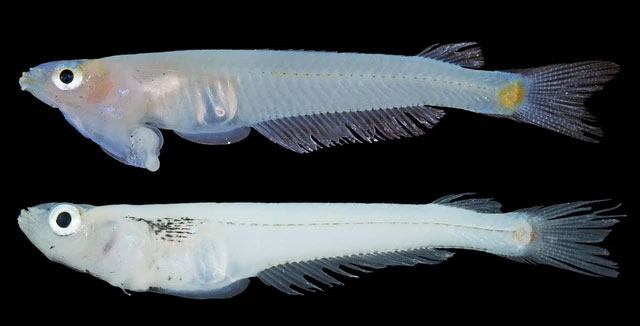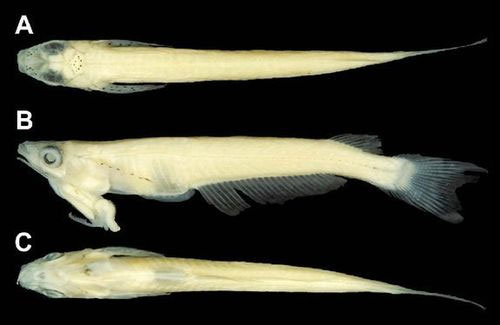Animals only found in Vietnam: Among the world's most evolved, unique mating methods
This animal was included in the list of 10 strangest discoveries in the world in 2012 by National Geographic .
Discover a new species
In July 2009, Koichi Shibukawa, a scientist from the Nagao Natural Environment Foundation in Tokyo, Japan, discovered a new species while he was observing a small canal of the Hau River - part of the Mekong River system - in Cu Lao Dung district, Soc Trang province, Vietnam.
During the collaboration with colleagues from Can Tho University, including Dr. Tran Dac Dinh and Master Tran Xuan Loi, he realized that this was a previously unknown species. The research on this new fish species was published in the scientific journal Zootaxa issue 3363 in July 2012.

Research on this new species was published in the scientific journal Zootaxa in 2012. (Photo: VietnamNewFish)
The Mekong Headfish (scientific name: Phallostethus cuulong ) is a ray-finned fish belonging to the family Phallostethidae, order Phallostethidae, found in Vietnam in 2009 and announced as a new species in 2012. They are considered a rare surface fish living in the Mekong River region in Southeast Asia, Asia.
The scientific name of this fish can be understood as follows : The name of the genus and family of this fish is of Greek origin, meaning penis (phallos) on the chest (stēthos): phallos + stēth + suffix us = Phallostethus. The English name priapiumfish of this fish group is named after the ancient Greek fertility god, Priapus, the species name (cuulong) is named after the river where it was first discovered.

The standard length of this fish is 25mm. (Photo: Huffpost).
The genus Phallostethus currently has 3 species found. In addition to P. cuulong, there are also P. dunckeri (CT Regan, 1913) in the Malay Peninsula and P. lehi (Lynne R. Parenti, 1966) in the Northwest of Borneo. Phallostethus cuulong is the 22nd species in the family Phallostethus discovered. And the Cuu Long Phallostethus is also endemic to Vietnam , not existing anywhere else in the world.
Fish species have special mating mechanism
This fish is characterized by its genitals located just below the chin, behind the mouth. Males have a priapium, an organ that resembles a penis but is inverted and resembles a type of pectoral fin. This organ helps increase the fertilization rate of eggs, helping the female fish's oviduct to contain more sperm. Meanwhile, the female fish's genitals are located inside their mouth.
This fish has a unique mating mechanism in which the male places his head close to the female, creating an angle of about 45 degrees. Although there are no specific records of their mating process, scientists speculate based on their body structure and comparisons with similar species that they use saw-like and whip-like appendages to attract females during the breeding season. Males will develop a penis extending from their head like a saw hook to grip onto females during mating.

This fish species has a special mating mechanism. (Photo: Zootaxa).
Accordingly, this is a fish species that is among the most evolved in the world as it is one of the few species where egg fertilization takes place outside the female's body.
Scientists still don't know why priapiumfish have this special genital structure, said Lynne Parenti, a researcher at the Smithsonian Institution in Washington DC. They belong to a family of fish called Atherinomorpha – in which the pectoral fins have evolved to "transport sperm ," Parenti added.
Eight specimens of P. cuulong were studied, including five males and three females, ranging in size from 20 to 24.5 mm. Their body parts were measured as a percentage of their body size, including: head length from 22.1% to 24.1%, snout length from 7.5% to 8.5%, eye diameter from 6.7% to 7.3%, interorbital width from 3.3% to 5.2%, jaw length from 8.0% to 9.4%, predorsal length from 78.0% to 82.6%, preanal length from 46.4% to 48.7%, and thickest body part from 15% to 18.7%.
- Bizarre mating of animals
- 10 species of animals with strange mating behavior in the world
- Antelopes fool children into mating
- The most cruel
- Hot scenes of animals
- An animal list has a unique sound
- Special communication methods of animals
- Find out the origin of humanity's first mating
- The eyes of the 'sea slug' are 'falling in love'
- Close-up of mating of 2 sea slugs
- Python gives birth to babies without mating
- The speed of the evolution of the lizard's amazing little boy
 Animal 'suffering' after hibernation
Animal 'suffering' after hibernation Why do goats climb well?
Why do goats climb well? Scientists were surprised to see chimpanzees eating turtles
Scientists were surprised to see chimpanzees eating turtles Giant catfish died deadly due to drought in Thailand
Giant catfish died deadly due to drought in Thailand